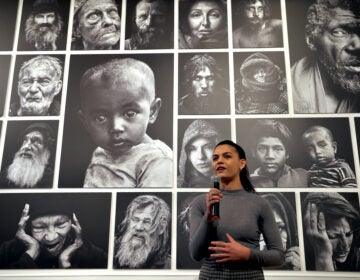The trauma caused by viral videos of police killing Black men
Watching videos of police killings, like the one of Walter Wallace Jr., can be traumatic, especially for Black and brown people. Should people share them anyway?
Listen 15:04
Community leaders and members of the clergy led a march Tuesday from the site where Walter Wallace Jr. was killed to the police precinct at 55th and Pine (Emma Lee/WHYY)
A cell phone video of the killing of West Philadelphia resident Walter Wallace Jr. was viewed more than a 1 million times within 24 hours of his death. A week later, the Philadelphia Police Department released the official body camera footage of the shooting. Both were undeniably disturbing.
There are two schools of thought about whether people should share videos of police killing Black men. One says yes, spread the word far and wide to raise awareness about police brutality and systemic racism. Another says no, because they’ll often autoplay on social media and watching them could be traumatic, especially for Black and brown people.
Guest Layla A. Jones of WHYY’s Billy Penn explains the mental health side effects of viral police videos, and offers tips for helping heal from the trauma.

Hear the whole story on The Why
Interview highlights
On whether to watch the videos
ANNETTE: …I remember when I first watched a video of police beating a Black man way back in 1991. The newspaper that I was working for at the time in San Jose, California, sent me to L.A. to cover the Rodney King trial. And people may remember that Rodney King was the unarmed Black man who was assaulted by a group of L.A. cops after a traffic stop. So anyway, because I had been assigned to cover that trial, I had to watch that video over and over again. And I had just had my son, he was a baby. And watching it… made me kind of sick to my stomach. And I just kept thinking if that was my own son and what is the future going to look like for him? And, you know, ever since then, I try to avoid watching those videos. I don’t think I’ve ever watched another one.
LAYLA: Yeah, I don’t watch those kinds of videos either. But in this instance, in the Walter Wallace Jr. police killing, I did have to watch that video for work kind of similarly to you. And I did post for the story I worked on about police shooting videos. I posted a poll on Twitter and asked if people still watch the videos. Most people did say no, but a good amount of people said that it depends. So they kind of watch those videos on a case by case basis.
On the traumatic effects of watching the videos
LAYLA: I spoke with a researcher in the U.K. named Dr. Pam Ramsden. Her studies have focused on mental health effects of watching these videos. So in her research, she found that when people viewed violent news events, about 20 percent of that group was profoundly affected, as she put it.
DR. PAM RAMSDEN: Of those 20 percent, about 1 percent will go on to have PTSD. That’s related to what they’re viewing, if that makes sense. So it is a small number, but it’s still relatively significant because in the past, we believed that PTSD could only be experienced by someone who was within the moment of the trauma. And now we’re finding that’s not true, that people can be affected vicariously, by physically watching.
On ways to cope with the trauma
LAYLA: This is what Dr. Howard Stevenson from Penn is all about. He talked about something called the CLCBE strategy, which means calculate, locate, communicate, breathe and exhale. When you begin to feel anxiety, get twitchy, hot or angry from watching these videos, it means calculate what you’re feeling. What feelings are you having? How many are there and how intense are they from one to 10? Then he said, locate where those feelings may have manifested in the bodies. Are your shoulders tense or your face scrunched up? Does your back hurt? Is your leg twitching? And then communicate with yourself by assessing any self talk or memories that were triggered by a video. And then finally, he said, breathe in for four seconds and exhale for six seconds.
WHYY is your source for fact-based, in-depth journalism and information. As a nonprofit organization, we rely on financial support from readers like you. Please give today.






